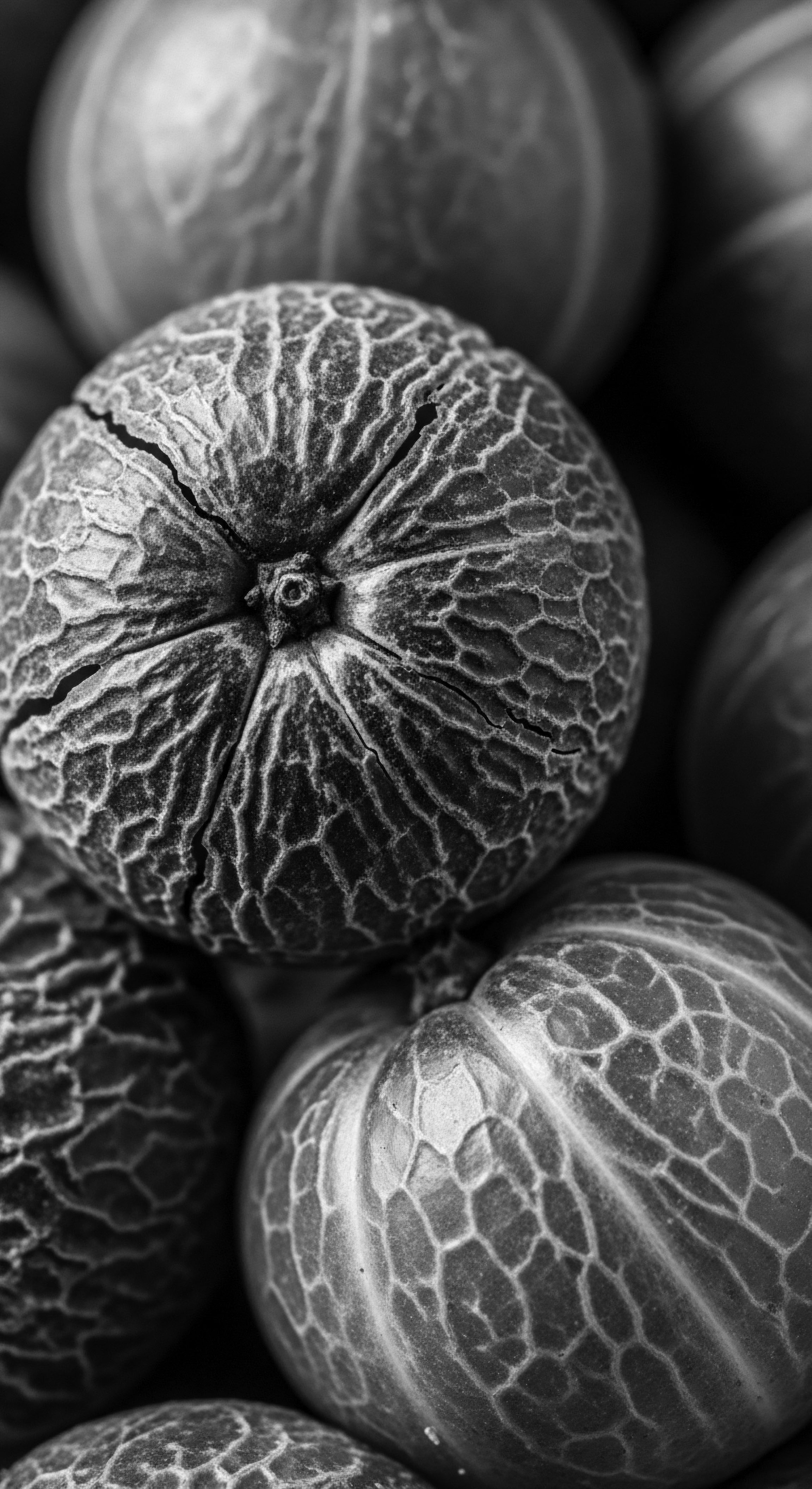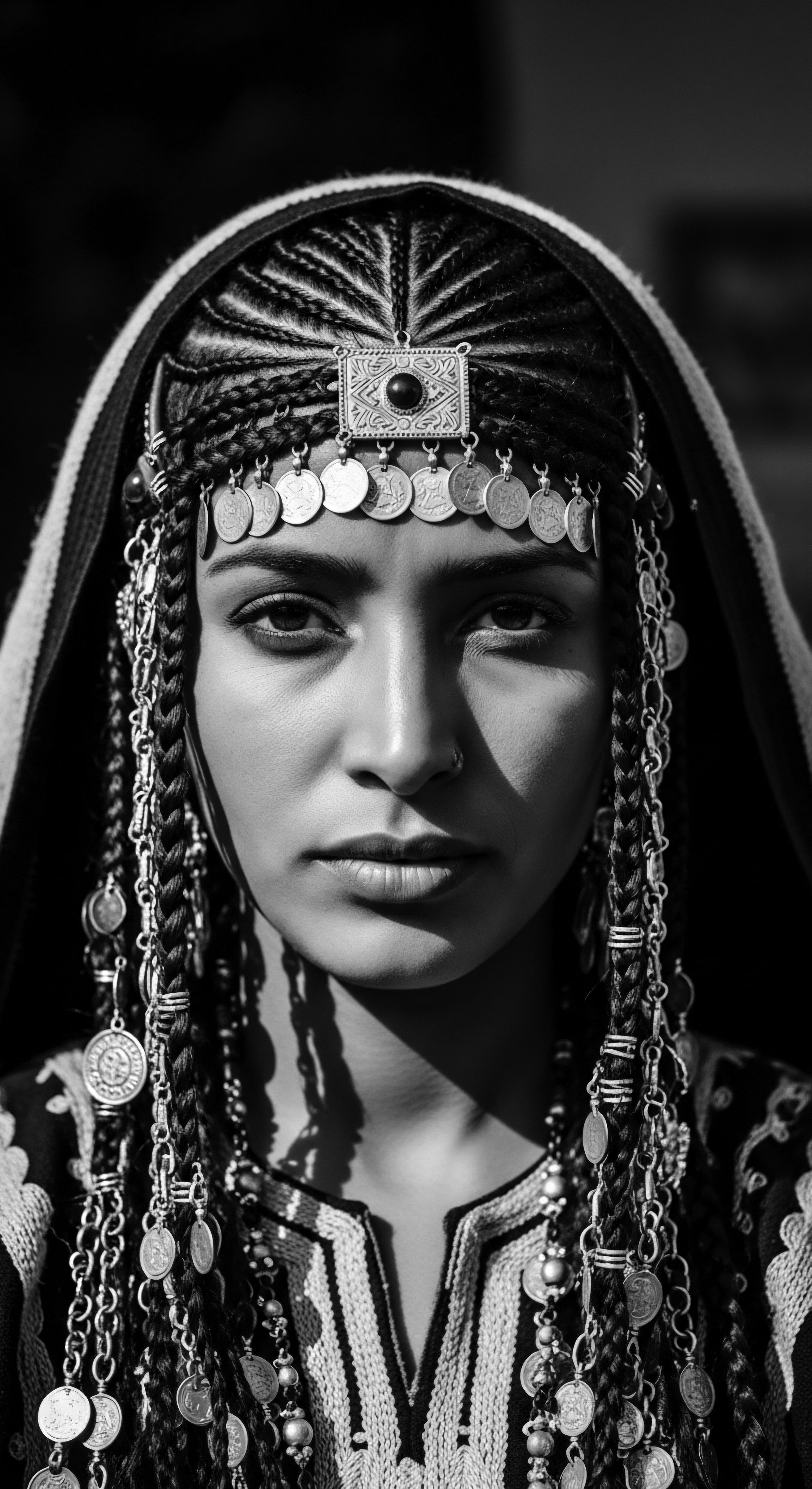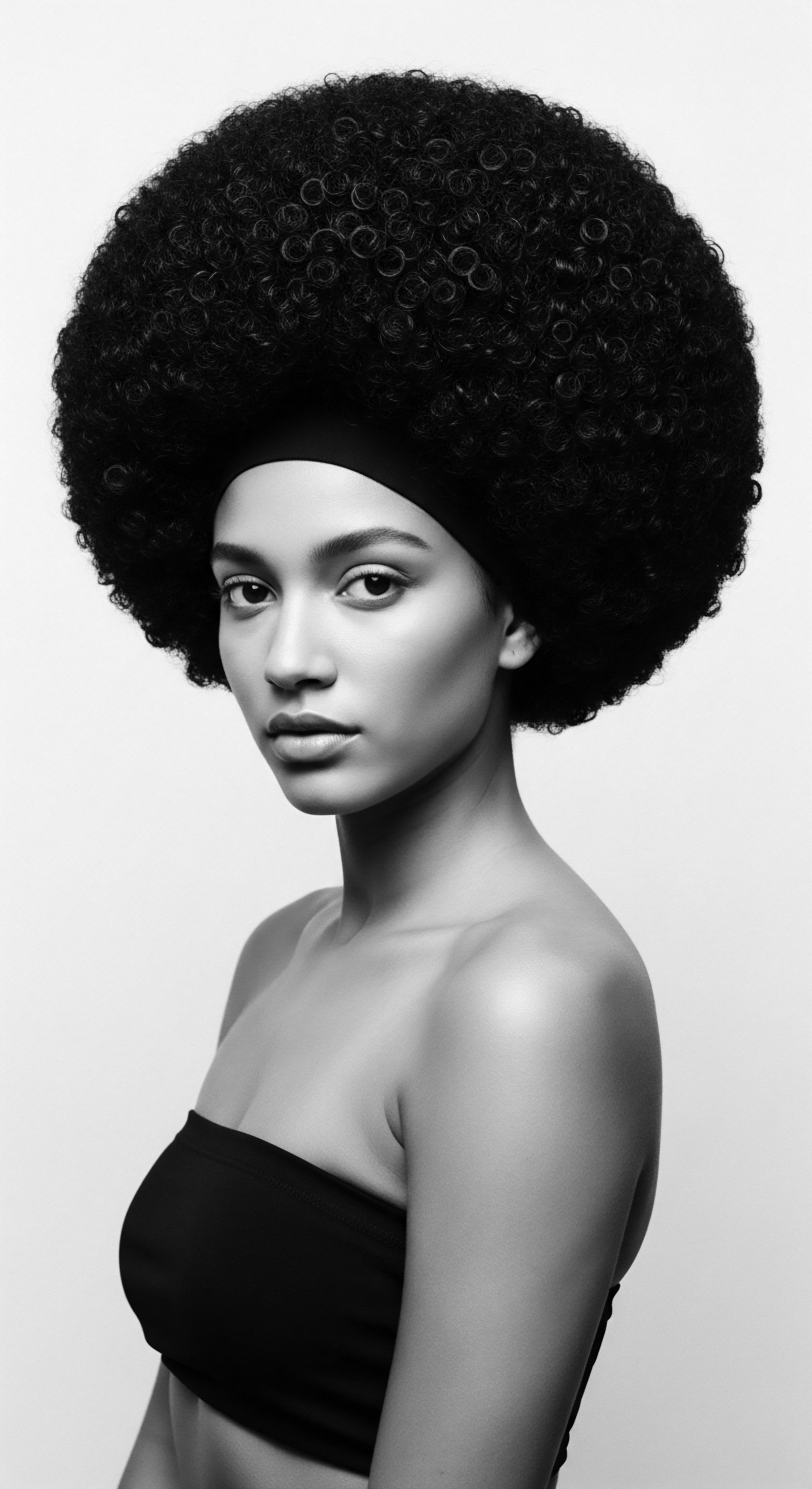
Roots
The stories whispered through generations, carried in the cadence of a grandmother’s comb upon a child’s scalp, tell us something fundamental about textured hair. This is not merely about strands and follicles; it is a living archive, etched into our very being, a testimony to enduring spirit. To speak of ancestral hair practices and their influence on resilience means reaching into the soil of our collective past, recognizing how care rituals, passed down through Black and mixed-race communities, became acts of preservation.
These traditions did not just tend to the physical state of hair; they fortified identity, articulated belonging, and built powerful connections. Each coil, every wave, holds the memory of hands that braided, oiled, and adorned, crafting a heritage of fortitude that extends far beyond the surface.
Consider the intricate dance of hair with identity in ancient West African societies. Before the profound ruptures of the transatlantic slave trade, hair served as a visual language, conveying one’s age, marital status, social standing, or tribal affiliation. Hairstyles could even signal spiritual beliefs or community roles. For instance, the Yoruba people of Nigeria fashioned elaborate styles, like the “Irun Kiko” (a form of thread-wrapping), which carried meanings related to femininity, marriage, and rites of passage.
Braids could indicate a woman’s marital status or fertility. In Yoruba cosmology, hair held sacred significance, seen as a conduit of spiritual energy linking individuals to their ancestors and deities. This deep connection meant that tending to hair was a sacred responsibility, a ritual that honored both the individual and the collective heritage.
Ancestral hair practices are not just methods of care; they are living testaments to identity, communal bonds, and unyielding spirit.
Hair anatomy itself, for textured hair, speaks to a history of adaptation. The elliptical cross-section of textured hair strands, often leading to a natural curl pattern, grants it unique characteristics. This architecture can contribute to a tendency for dryness, as natural oils from the scalp travel with less ease down the spiraling shaft compared to straight hair. Yet, this very structure also lends itself to remarkable versatility in styling, allowing for volume, protective configurations, and cultural expression that flat, straight hair cannot replicate.
Understanding this inherent biology becomes clearer when placed within a historical context. Ancestral communities understood these qualities intuitively, developing care practices designed to nourish, protect, and celebrate this unique morphology. They understood that moisture retention and scalp health were paramount, long before modern science articulated the precise cellular mechanisms.

Hair’s Elemental Being ❉ A Heritage Perspective
The fundamental understanding of textured hair’s biological makeup is incomplete without acknowledging the ancestral wisdom that preceded contemporary scientific discovery. Early civilizations possessed a profound empirical knowledge of what their hair needed. They observed its tendencies, its reactions to climate, and its inherent strengths and vulnerabilities. This observational science, rooted in generations of lived experience, formed the first codex of textured hair care.
- Cuticle Layers ❉ The outermost layer, composed of overlapping cells, acts as a protective shield. In textured hair, these layers might be more lifted, contributing to moisture loss but also allowing for greater product absorption.
- Cortical Cells ❉ The middle layer gives hair its strength and elasticity. The unique shape of textured hair’s cortex contributes to its coily or curly pattern, making it strong yet prone to breakage if mishandled.
- Medulla Presence ❉ The innermost core of the hair shaft, which may or may not be present in all hair types, can also influence the hair’s overall properties.

What Did Traditional Classifications Reveal About Hair?
While modern systems, such as Andre Walker’s typing (1A to 4C), aim to categorize hair texture, ancestral societies had their own, often more holistic, classification methods. These were not merely about curl pattern, but about how hair related to one’s lineage, status, and community. A particular braid, a specific adorned coiffure, or the length of locs could instantly communicate a person’s identity. These systems, though unwritten in a scientific journal, were deeply embedded in daily life and communal understanding.
They reflected a qualitative appreciation of hair’s diverse forms, each recognized for its inherent beauty and cultural meaning. This stands apart from modern classifications that, at times, have been influenced by Eurocentric ideals, creating a hierarchy where straighter textures were viewed as more desirable or “good” (Byrd & Tharps, 2001). The reclamation of natural hair today, supported by movements like the CROWN Act, directly challenges these historical biases, asserting the beauty and validity of all textured hair.
Hair growth cycles, too, were understood through a lens of holistic wellness. Ancient practitioners recognized that factors beyond direct hair manipulation, such as diet, environmental conditions, and overall spiritual well-being, impacted hair health. This knowledge informed the use of locally sourced ingredients and communal rituals that supported the entire person, not just the hair itself.
The essential lexicon of textured hair, therefore, begins not with scientific terms but with words that speak to identity and purpose. Terms like Cornrows, Locs, Braids, and Twists carry centuries of meaning, representing not just styles, but acts of resilience, communication, and artistry that have been passed down through generations. These words embody a tangible link to our heritage, reminding us that care for textured hair is a continuum, rooted in ancestral practices.

Ritual
The creation of textured hair styles has always been an art, a science, and a communal ritual, deeply woven into the very fabric of heritage. From the simplest partings to the most intricate arrangements, these practices were never purely about aesthetic appeal. They were acts of storytelling, expressions of status, and often, quiet declarations of resistance.
The how of these practices reveals a profound understanding of hair’s properties, long before modern scientific laboratories provided explanations. Ancestral ingenuity, born of necessity and deep knowledge of the natural world, crafted methods that guarded hair, encouraged its strength, and celebrated its unique forms.

Ancient Hands, Enduring Forms ❉ What Techniques Shaped Resilience?
The protective styling encyclopedia, if one were to compile it from the annals of our past, would be vast and varied. Many styles we recognize today find their genesis in pre-colonial African societies. Cornrows, for instance, are not merely a style; they are a historical record, dating back as far as 3500 BCE, with depictions found in rock paintings in the Sahara desert. These tightly braided rows, lying flat against the scalp, were incredibly practical, keeping hair neat and shielded from environmental elements.
Beyond practicality, they were profound tools of cultural expression, communicating tribal identity, age, and social rank. During the transatlantic slave trade, their meaning deepened further. Enslaved Africans, stripped of many cultural markers, used cornrows as a covert language. In Colombia, specific patterns were crafted to create maps and directions for escape routes, sometimes even hiding seeds within the braids for survival upon reaching freedom. This single historical example powerfully illuminates how ancestral hair practices were not just about beauty, but about survival and unwavering resilience.
Other traditional methods, such as Threading, also protected hair from breakage and aided length retention. Among the Yoruba people, “Irun Kiko” involved tying hair sections with flexible wool or cotton threads, wrapping them into corkscrew patterns. This ancient technique, noted as early as the 15th century, stretched the hair and protected it. Such methods highlight a sophisticated understanding of how to manipulate hair with minimal tension, fostering its health.
Hair styling, born from ancestral traditions, was a language of survival and cultural preservation, its forms holding encoded histories.
Natural styling and definition techniques were intrinsically linked to the environment. Without a myriad of manufactured products, ancestral communities relied on what the earth provided. This included the use of water, hands, and the natural elasticity of textured hair to create definition.
Bantu Knots, a traditional African style, coil sections of hair into tight knots, creating defined curls when unraveled. This method, originating from the Bantu-speaking peoples, demonstrates an intuitive understanding of how to encourage hair’s natural curl pattern while keeping it contained and protected.
| Ancestral Tool Wooden Combs and Picks |
| Purpose and Heritage Used for detangling, parting, and styling. Archaeological evidence suggests ancient combs from Kush and Kemet (present-day Sudan and Egypt) dating back 7,000 years, often adorned with animal motifs, signifying respect for nature and indicating social status. |
| Modern Parallel or Validation Wide-tooth combs and Afro picks continue to be essential for gently detangling textured hair without causing undue stress or breakage. |
| Ancestral Tool Heated Metal Combs (with Shea Butter) |
| Purpose and Heritage In some Ghanaian traditions, women would heat metal combs and dip them in shea butter to straighten or soften hair. |
| Modern Parallel or Validation Modern pressing combs and flat irons, though often used with higher heat, share a conceptual lineage, albeit with different safety and product considerations. |
| Ancestral Tool Clay Pots for Storage |
| Purpose and Heritage Shea butter and other natural oils were stored in clay pots, preserving their properties in warm climates. |
| Modern Parallel or Validation Airs-tight containers and dark glass bottles are used today to maintain the integrity and shelf-life of natural hair products, mirroring ancient preservation methods. |
| Ancestral Tool These tools, simple yet ingenious, underscore the deep connection between ancestral resourcefulness and enduring hair health practices. |

How Did Hair Accessories Reflect Identity and Community?
The complete textured hair toolkit of the past extended beyond functional instruments to include adornments that amplified cultural identity. Beads, cowrie shells, and precious metals were not mere decoration; they were symbols of status, spirituality, or rites of passage. In ancient Egypt, elaborate wigs and braids were adorned with gold, beads, or other materials, signifying wealth, religious devotion, and connection to deities. The act of communal hairstyling, a practice often spanning hours, reinforced community bonds and transmitted cultural knowledge across generations.
Mothers, daughters, and friends gathered, transforming hair care into an act of collective identity formation. This communal aspect, a living legacy, speaks to a deeply social dimension of textured hair care, far removed from the individualized routines prevalent today.
Even in the face of colonial influences and forced assimilation, these practices persisted. The rise of nationalism in the 20th century saw a resurgence of pride in traditional hairstyles, with the Afro becoming a powerful symbol of Black pride and unity during the Civil Rights Movement. This historical continuum demonstrates how the art and science of textured hair styling have always been tied to a broader narrative of self-determination and cultural celebration.

Relay
The wisdom of ancestral hair practices, honed over centuries, is a living blueprint for cultivating textured hair resilience. It is a tradition that continues to inform our understanding of holistic care, nighttime rituals, and problem-solving, all viewed through the lens of heritage. This understanding bypasses superficial approaches, offering profound insights backed by empirical observation and, increasingly, modern scientific validation. The journey from elemental biology to sophisticated care practices is a relay, a passing of knowledge from one generation to the next, adapting and enduring.

Building a Personalized Regimen ❉ What Ancestral Wisdom Informs Modern Care?
Crafting a personalized textured hair regimen today finds deep inspiration in ancestral wisdom. Before the advent of mass-produced hair products, communities relied on natural resources and a keen understanding of hair’s needs. Their regimens were inherently holistic, considering not just topical treatments, but also diet, environment, and overall well-being. Ingredients were locally sourced and applied with intention.
For example, Shea Butter, extracted from the nuts of the shea tree, has been a staple in West African hair care for centuries. Women in Ghana and Nigeria used it to moisturize and protect hair from harsh environmental conditions, recognizing its ability to promote health and growth. Similarly, African Black Soap, made from plantain skins, cocoa pods, and palm oil, was used for deep cleansing and nourishing the scalp. These traditional ingredients were chosen for their moisturizing, cleansing, and protective properties, laying a foundation for resilient hair.
The scientific understanding of these ancestral remedies often validates their efficacy. Shea butter, for instance, is rich in vitamins A and E, and essential fatty acids, contributing to its moisturizing and healing properties. African black soap provides gentle exfoliation and nourishment to the scalp, promoting a healthy environment for hair growth. This alignment between ancient practice and modern science underscores the enduring value of traditional knowledge.

The Nighttime Sanctuary ❉ How Did Sleep Protection Aid Hair Longevity?
The ritual of nighttime hair protection is perhaps one of the most direct and impactful ancestral practices that continues to shape textured hair resilience. For centuries, headwraps and coverings were used not only for ceremonial purposes but also to shield hair from the elements, maintain moisture, and prevent tangling and breakage during sleep. This practice was particularly vital for enslaved Africans, who used headwraps to protect their hair from harsh labor conditions while subtly asserting their cultural heritage. This was a pragmatic response to preserve hair health when resources were scarce and conditions brutal.
The modern Bonnet, often made of satin or silk, is a direct descendant of these historical coverings. Its purpose remains the same ❉ to reduce friction against absorbent pillowcases, thereby minimizing dryness, frizz, and mechanical damage. This simple, yet profound, act of nightly protection is a quiet testament to the enduring legacy of ancestral care, recognizing the need to preserve hair’s integrity, especially during periods of rest.
Nighttime hair protection, a ritual passed down through generations, underscores the ancestral understanding of preserving hair’s inherent moisture and delicate structure.
The understanding of textured hair problem-solving also benefits from ancestral wisdom. Issues like dryness, breakage, and scalp irritation were addressed with natural remedies tailored to specific needs. Rather than chemically altering hair, traditional solutions focused on nourishment and strengthening the hair from within. This preventive and restorative approach speaks to a deep connection to the body’s innate healing capabilities, often drawing on botanical knowledge.
- Oiling and Sealing ❉ Ancestral communities regularly applied oils like Palm Kernel Oil or Baobab Oil to moisturize and protect hair. This practice helped to seal in moisture and provide a protective barrier.
- Herbal Rinses ❉ Herbs like Neem and Hibiscus were used in rinses to address scalp issues, promote hair growth, and add conditioning effects.
- Protective Styling ❉ As discussed, styles like braids, twists, and cornrows were not just decorative; they minimized manipulation, reducing breakage and allowing hair to retain length.
Holistic influences on hair health, deeply rooted in ancestral wellness philosophies, viewed the hair as an extension of one’s overall vitality. A balanced diet, spiritual well-being, and community support were all considered vital components of true hair health. This perspective encourages us to look beyond topical treatments, urging a deeper consideration of how our internal landscape impacts our external crowning glory. This holistic approach continues to ground Roothea’s philosophy, recognizing that textured hair resilience is a multifaceted construct, drawing strength from history, science, and the profound wisdom of those who came before us.

Reflection
The journey through ancestral hair practices reveals more than just methods of care; it uncovers a testament to enduring human spirit, a vibrant heritage woven into the very fabric of our textured hair. From the elliptical architecture of each strand, understood through centuries of empirical observation, to the intricate braids that once served as secret maps to freedom, our hair stands as a living narrative of survival and triumph. The persistent use of gifts from the earth, like rich shea butter and cleansing black soap, mirrors a deep, intuitive science, now often validated by modern study. These practices, once acts of necessity and cultural expression, continue to resonate, reminding us that care for textured hair extends far beyond the superficial.
It is a profound connection to lineage, a celebration of identity, and a quiet declaration of self-possession. The legacy of resilience, passed through nimble fingers and communal gatherings, forms the unbreakable bond that links every strand to the Soul of a Strand, echoing the voices of those who found strength and beauty in their coils, kinks, and curls.

References
- Afriklens. (2024). African Hairstyles ❉ Cultural Significance and Legacy.
- Byrd, A. D. & Tharps, L. L. (2001). Hair Story ❉ Untangling the Roots of Black Hair in America. St. Martin’s Press.
- Childish Mane LLC. (2024). Embracing Roots ❉ The Resilience of African American Women Through Their Natural Hair.
- Diop, C. A. (1987). Precolonial Black Africa ❉ A Comparative Study of the Political and Social Systems of Eurasia and Black Africa from Antiquity to the Formation of Modern States. Lawrence Hill Books.
- Dabiri, E. (2020). Twisted ❉ The Tangled History of Black Hair. Harper Perennial.
- Davis-Sivasothy, A. (2011). The Science of Black Hair ❉ A Comprehensive Guide to Textured Hair Care. SAJA Publishing Company.
- Johnson, T. A. & Bankhead, T. (2014). The importance of hair in the identity of Black people. Journal of Black Studies, 45(1), 87-104.
- University of Salford Students’ Union. (2024). The Remarkable History Behind Black Hairstyles.
- Odele Beauty. (2024). A History Lesson On Hair Braiding.
- KhalidaNaturals. (n.d.). Natural Hair Care for Kinky, Coily Textures.
- Obscure Histories. (2024). Ancient Gems ❉ A Historical Survey of African Beauty Techniques.
- Global Mamas. (n.d.). Ancient Shea & Modern Moringa ❉ a Winning Combination.
- Ciafe. (2023). Shea Butter – Explainer.
- Africa Imports. (n.d.). Traditional African Secrets For Long And Healthy Hair.
- My Sasun. (2023). Exploring the Rich World of Nigerian Hair and Beauty Products.
- The CROWN Act. (n.d.). About — The Official CROWN Act.
- Monmouth University. (2025). The History of Black Hair.
- Voyant Beauty. (n.d.). What is the CROWN Act? Promoting Hair Equality and Inclusivity.
- The Queen’s Journal. (2025). History, identity, and community ❉ The significance of Black hair.
- University of Salford Students’ Union. (2024). The Remarkable History Behind Black Hairstyles.
